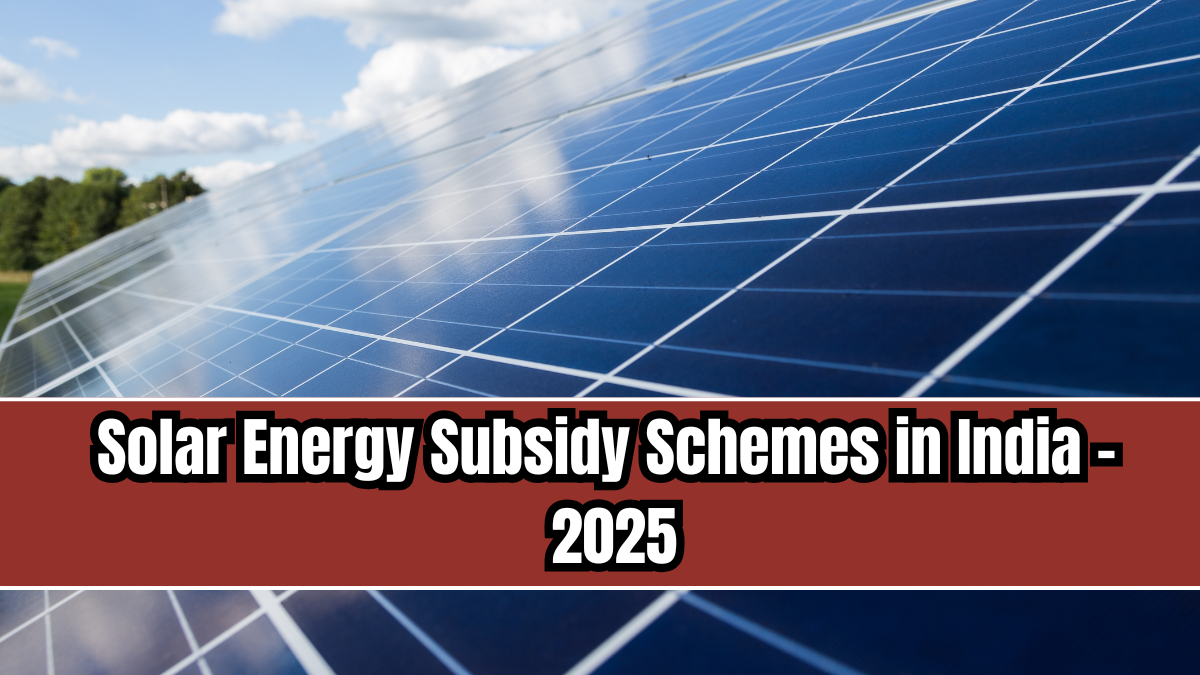India’s renewable energy sector is growing rapidly, and solar power remains the backbone of this transformation. To make solar energy more affordable, the government has rolled out Solar Energy Subsidy India 2025 schemes, giving households, businesses, and institutions financial support to install solar panels. With rising electricity bills and the urgent need for clean energy, these subsidies are helping millions of Indians switch to sustainable power sources.

Why Solar Subsidies Are Important
Solar energy systems require significant upfront investment, which often discourages adoption. Government subsidies reduce these costs, making solar installations accessible to middle-class households and small businesses. The benefits go beyond affordability:
-
Lower monthly electricity bills.
-
Reduced dependence on fossil fuels.
-
Long-term savings after payback period.
-
Contribution to India’s renewable energy goals.
-
Increased employment in solar manufacturing and installation.
By 2025, subsidies are seen as a key tool to accelerate the transition to green energy.
Government Initiatives in 2025
The Indian government has launched several subsidy programs under the Ministry of New and Renewable Energy (MNRE). These initiatives are designed to support rooftop solar, grid-connected systems, and solar for agricultural use.
-
Residential Rooftop Subsidy: Households installing rooftop solar panels can claim subsidies covering up to 40% of the system cost, depending on capacity.
-
PM Surya Ghar Muft Bijli Yojana 2025: Provides free electricity up to a set limit for households that adopt rooftop solar.
-
Agricultural Solar Pump Subsidy: Farmers receive subsidies for solar-powered irrigation pumps, reducing dependence on diesel and grid electricity.
-
Community and Institutional Subsidies: Schools, hospitals, and panchayats can access financial support for solar projects.
-
Net Metering Incentives: Consumers feeding excess solar power back into the grid get additional financial credits.
These programs reflect the government’s focus on making solar accessible at every level.
Eligibility for Solar Subsidies
To benefit from the solar panel subsidy schemes, applicants must meet certain criteria:
-
Residential Users: Homeowners with registered property and rooftop space.
-
Farmers: Those applying for solar pumps under government schemes.
-
Institutions: Recognized schools, hospitals, and government offices.
-
Capacity Limitations: Subsidies are usually provided for systems up to 10 kW for households, and higher for community projects.
-
Vendors: Installations must be done by MNRE-approved vendors to qualify.
Application Process for Subsidy
The subsidy process in 2025 has been simplified with digital platforms. Applicants can:
-
Register on the official MNRE or state renewable energy portal.
-
Submit details of their rooftop or land area.
-
Select an approved vendor from the listed panel.
-
Install the system with proper inspection and net-metering setup.
-
Upload installation proof and documents online.
-
Receive the subsidy amount directly in their bank account.
This transparency ensures faster and more reliable disbursement of funds.
Benefits of Solar Subsidy in 2025
The Solar Energy Subsidy India 2025 offers multiple advantages:
-
Cost Reduction: Cuts down initial installation costs significantly.
-
Affordable Green Power: Households can generate their own electricity at lower costs.
-
Energy Independence: Reduced dependence on unstable grid power.
-
Eco-Friendly Impact: Helps India meet its carbon reduction commitments.
-
Job Creation: Expands opportunities in installation, sales, and manufacturing.
Challenges in Implementation
While subsidies are popular, there are challenges too. Many rural households remain unaware of these schemes. Delays in vendor approvals and inspections sometimes slow down installations. Upfront costs, even after subsidies, can still be high for lower-income families. To overcome this, the government is working on financing support and micro-loans to make solar more accessible.
Future Outlook of Solar Energy Subsidies
The future looks bright for solar in India. By 2030, the government aims to achieve over 280 GW of solar capacity, and subsidies will play a central role in achieving this. With falling solar panel costs and technological innovations like solar-plus-storage, subsidies are expected to decrease gradually as the market matures. However, in 2025, they remain a powerful incentive driving adoption.
Final Thoughts
The Solar Energy Subsidy Schemes in India – 2025 are a game changer for households, farmers, and businesses. By making solar energy affordable and accessible, these subsidies are helping India transition to clean energy while reducing electricity bills for millions of citizens. For anyone considering solar installation in 2025, government incentives make it the best time to invest in sustainable power.
FAQs
How much subsidy is available for rooftop solar in 2025?
Up to 40% subsidy is available for small residential rooftop systems, depending on the capacity installed.
Who is eligible for solar energy subsidies?
Homeowners, farmers, schools, hospitals, and institutions using MNRE-approved vendors are eligible.
How can I apply for solar subsidies in 2025?
You can apply through the MNRE or state renewable energy portal, select an approved vendor, and upload installation documents.
Are subsidies available for farmers in 2025?
Yes, farmers get subsidies on solar-powered irrigation pumps under government programs.
Will solar subsidies continue in the future?
Subsidies will remain in 2025 and gradually reduce as solar adoption increases and panel costs drop.
Click here to know more.
